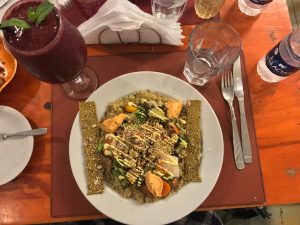
The following post was contributed by Alumni Memorial Scholars seniors Ashlea Raemer and Revee Needham, who recently completed an independent research project, using their AMS grant funds, studying vegetarian food in Argentina.
Together we, Ashlea Raemer and Revee Needham, decided to complete our AMS project on the accessibility of vegetarianism in Buenos Aires, Argentina. Historically, Argentina has been heavily influenced by meat consumption, specifically beef. This started when the Spanish conquistadores brought cattle, which then flourished in the flat grassland pampas. Today, those legacies remain, as Argentines are the second highest meat consumers per capita in the world (source). Searching for ways to have an ‘authentic’ Argentine experience or to-do’s while visiting, tourists are directed towards an asado, the equivalent of a beef barbecue. Thus, we sought out to find answers: Is it possible to affordably eat vegetarian food? Are vegetarian-marketed restaurants spatially aggregated in a certain part of the city? Is vegetarian culture like that in the US?

The Italian influence is seen at Pierino
On our first full day, we began to realize the influence of Italian immigration into Argentina and its impact on cuisine. We dined at an Italian restaurant, Pierino, for dinner, with numerous pasta options to choose from, including vegetarian options that were comparable in price to meat pastas. The Italian influence was seen too in a traditional Argentine steakhouse, a parilla, where pasta was also available. Pizza too was an option we found at many restaurants, while meat was a topping, all restaurants had a simple muzerella option. Thus, the Argentine food scene was much less homogenous than we had expected, more similar to the multicultural diversity in the United States.
Of all the meals, breakfast was the most vegetarian-friendly. It’s common to grab a pastry, often a medialuna, alongside a coffee, un café con leche. We frequented the French-inspired café Le Ble, where numerous breakfast options included toast, scrambled eggs, fruit, and more. Options did include meat, but many featured cheese or some lighter fare instead.

Ashlea with the empanadas at El Sanjuanito
One famous Argentine traditional food is the empanada. This is typically a pastry filled with meat, however many food bloggers indicated the availability of cheese filled empanadas as well. Disappointingly, many restaurants that served empanadas as an option were limited to meat, from the café in the famous bookstore, El Gran Ateneo, to La Biela, a tourist-centric restaurant in the heart of Recoleta. At a local fundraiser Bingo in Palena, Chile after our AMS trip, we called ahead to specifically request vegetarian empanadas and were met with disbelief and confusion. However, a renowned empanadas restaurant, El Sanjuanito, had a huge selection of empanadas, including a cheese and onion, veggie, and caprese style options. The empanada was different in that it encompassed a more traditional cuisine that contrasted with the health-conscious vegetarian-marketed restaurants. We were happy to finally find a vegetarian empanada!

A salad and smoothie at Buena Verde
Geographically, Buenos Aires has numerous neighborhoods, with different themes, inhabitants, and restaurants. Palermo Hollywood, is a newer neighborhood, filled with colorful graffiti and a younger vibe. Artemisia Cocina Natural and Buena Verde were both in Palermo Hollywood. Buena Verde was marketed as organic, natural, raw, emphasizing macronutrients. The restaurant itself was smaller and had a small selection of products you could purchase. Hierbabuena was in a different part of the city, Recoleta. Artemisia embodied a hipster vegetarian restaurant. The menu was written on paper bags and most of the tables were reserved ahead of time. The vegetarian restaurants seemed to largely market themselves to a richer crowd. Drawing comparisons to the US, vegetarianism is marketed as a health trend or holistic lifestyle in both countries.
Overall, it is possible to eat vegetarian in Buenos Aires and is more accessible than the meat-laden city would boast. It takes some time to figure out where vegetarian restaurants are and how to order meals without meat, especially in a different language!

